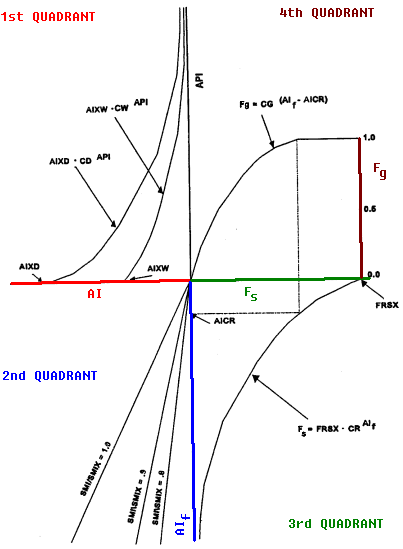
 An example of a coaxial four quadrant relationship is shown here along with a brief explanation of some of the more pertinent parameters.
An example of a coaxial four quadrant relationship is shown here along with a brief explanation of some of the more pertinent parameters.
Runoff for a given event is calculated by progressing from quadrant 1 through quadrants 2, 3, and 4.
The first quadrant converts API to AI based on wet and dry curves.
The second quadrant of the Continuous API Model adjusts the AI value computed in the first quadrant for the effect of surface moisture.
The result is an adjusted or final AI value (AIf).
It is assumed that when surface moisture conditions are wet then AIf=AI.
When surface moisture is dry, AIf needs to be increased.
This causes surface runoff to be decreased in the third quadrant to reflect interception, depression storage, and upper zone moisture losses that occur when the surface is dry.
The second quadrant accounts for the initial abstraction loss that occurs at the beginning of an event.
The third quadrant of the Continuous API Model computes surface runoff knowing AIf and the amount of precipitation.
It should be noted that some doubt exists as to whether the same relationship can be used for this quadrant in a continuous API model as is used in an event model.
Also the typical equations used for this quadrant in previous API models involve 4 or 5 parameters which are not easy to visualize.
Thus in this model a much simpler approach is used.
The fourth quadrant is used to compute that portion of the precipitation that doesn't become surface runoff.
That volume enters groundwater storage and eventually becomes baseflow runoff.
The water that doesn't become surface runoff or groundwater inflow enters soil-moisture storage or becomes recharged to deep aquifers.




 An example of a coaxial four quadrant relationship is shown here along with a brief explanation of some of the more pertinent parameters.
An example of a coaxial four quadrant relationship is shown here along with a brief explanation of some of the more pertinent parameters.

